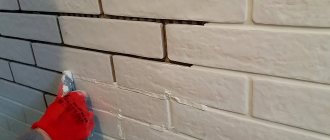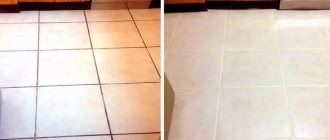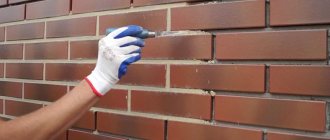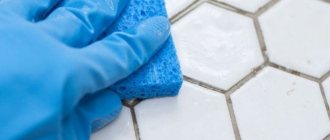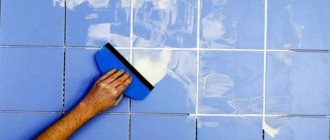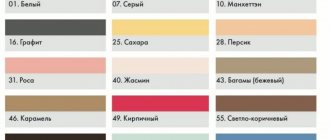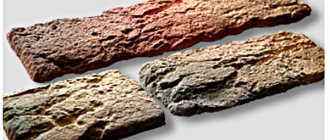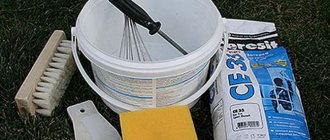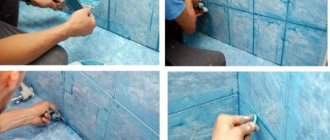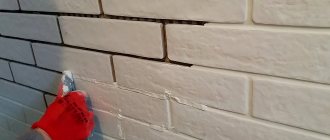Wall cladding with decorative stone continues to be in demand, as it allows you to create the effect of naturalness and luxury. However, after laying the materials, the spaces between them are finished, which makes the composition complete, holistic, and airtight. Grout for decorative stone can be purchased ready-made or prepared independently.
Types of grout for stone
To work with decorative stone, you can use the same material with which the elements were attached. However, experts recommend purchasing specialized compounds. They are resistant to external negative influences and have good elasticity. Based on the form of release, the following types of materials are distinguished:
- Dry. They are packaged in paper bags. Before use, the substance is diluted with water in the proportions specified in the instructions. Such material in dry form has a limited shelf life. It is better to choose it if you need to process a large area.
- Wet. They are easy to use as they are ready for use immediately after purchase. However, they need to be used quickly. If the container is opened, the material will quickly become unusable.
If the decorative material is fixed with cement mortar, then grouting is carried out with the same. All compositions are white or colored.
Preparatory activities
Joining can be carried out immediately after laying the brick or after erecting the walls. In the first case, the mason brings the masonry into proper shape after several rows have been completed and the mortar begins to set.
In the second case, when laying, the master leaves the outer part of the seam empty for subsequent filling with jointing mixture, and they begin refining the wall after a certain time has passed, necessary for complete shrinkage of the masonry.
Before restoring old masonry, it is necessary to remove the mortar from the joints to a depth of 15 mm and clean the wall from dust and dirt
Preparing the masonry is carried out in the following sequence:
- If it is necessary to update the cladding of an old wall, parts of the old jointing are removed from the seams to a depth of 10 - 15 mm. To avoid damaging the bricks, it is better to use a narrow wooden wedge and a hammer. If it is not possible to knock off parts of the frozen solution, use a chisel;
- Use improvised means to remove dust and dirt from the walls of the building;
- The seams are cleaned using a stiff brush or a high-pressure apparatus. This work should be carried out very carefully, since dirt and dust particles interfere with the adhesion of the jointing solution;
- After cleaning, the seams are moistened using a roller or soft brush and a bucket of water.
The preparation of the cement-sand mixture begins only after the surface has been completely prepared for the next stage, at which the jointing solution is prepared.
You can make the jointing mixture yourself or use a ready-made factory-made composition, which is sold dry. and in wet form. Since the solution is used for decorative purposes, concrete dyes can be added to it.
A concrete mixer will speed up the process of preparing the jointing mixture
If you prefer to do everything yourself, then to prepare the optimal mixture, take lime, sand and cement in a ratio of 1:10:1 and mix with water until the consistency of very thick sour cream is obtained. Remember that the composition remains mobile for up to 1.5–2 hours, so mix only the amount that you can use during this time.
If the mixture you receive is too liquid, you can remove excess moisture from it by placing dry red brick in a container with the solution for 1 - 2 minutes.
For large volumes of work and the presence of assistants, a concrete mixer will help speed up the process.
What are grouts made of?
Depending on the connecting element, there are different types of grout for decorative stone: epoxy, cement, latex. The materials also contain polymer additives that improve their properties. Depending on the main component, the grout can be:
- Plaster. The mixture is suitable for sealing joints between decorative stones indoors.
- Epoxy. It has a high level of moisture resistance. Thanks to special additives, it becomes immune to the effects of aggressive substances. This grout polymerizes quickly, so it is not easy to apply.
- Cement. It can be coarse-grained or fine-grained. The first type creates a pronounced textured surface. The composition looks natural. This material is prone to cracking, but the problem can be quickly eliminated. You should not use it to work with marble or glossy cladding.
- Polyurethane. The composition has a high price, but it is resistant to fading, moisture, and stains. Since the material does not dry very quickly, it is not difficult to work with.
- Silicone. It is elastic and provides a high level of tightness. Technical characteristics include resistance to negative temperatures and moisture.
- Latex. It has good adhesion parameters to the base, as it penetrates deep into the seam . No cracks have formed on it yet .
- Rubber. This type of grout is resistant to moisture and easy to apply. It is expensive, so finishing large areas is impractical. It is more suitable for interior walls of rooms where there is high humidity.
The technology for applying the material depends on the type of composition.
Preparing the solution
The color of the grouting solution is determined after the masonry is completely completed. But in general, you can choose the color scheme at the stage of choosing a brick. It is better to buy materials that match each other in color as closely as possible; they should be in harmony with each other, and not make you want to immediately look away from the wall of the house. But often designers experiment with a combination of two bright contrasting colors, and such experiments often look very impressive and beautiful.
Contrasting grout for seams
On a note! If the desired color was not available, then you can grout the seams with ordinary cement-sand mortar. In any case, it will look nice, as it has a grayish natural color that is in harmony with all other shades.
To prepare the mixture itself, which will be used to grout the joints on the brickwork, you will need the following components:
- high quality cement - 4 buckets;
- clean fine sand - 2 buckets;
- dry ready-mix for preparing grout mortar;
- clean water - about 6 liters.
Note: the volumes of materials are approximate, but will allow you to roughly calculate costs.
Cement-sand mortar
To prepare the solution, you need to carefully sift the sand using a fine sieve, removing large fractions and possible debris from it. One part of the entire sifted material must then be mixed with two parts of dry cement, after which a little water is added to this composition and everything is mixed to a thick mixture of uniform consistency with a construction mixer. Then the grout mixture and water are added, and everything is thoroughly mixed again.
The finished mixture should be allowed to brew. After the solution swells a little, having absorbed the liquid, it is mixed again. That's it, the solution is ready for use.
Quick Mix series VK 01 – Masonry mortar with route for facing bricks
How to apply grout and how it can be done
Filling the seams of decorative stone is carried out using a spatula or a syringe gun. Methods of applying the material are as follows:
- Inside the seam. The solution is compacted as much as possible. If necessary, the recess is increased. The stone protrudes outward.
- Convex. A special spatula is used to apply the composition. The grout protrudes over the stone.
- Flush. The mixture is laid at the same level as the cladding. Excess material must be removed immediately.
- Beveled. After applying the solution, part of it is removed at an angle using a trowel.
The most difficult is the triangular method, as it requires certain skills.
Application technique using a syringe gun
Using a special device, grouting of joints is carried out quickly, and contamination of the cladding is minimal. It is used if you need to treat a large area. The gun is suitable for working outdoors with sandy or porous substrates. The technology for applying the composition involves the following work:
- cleaning joints with a stiff brush;
- moistening the seams (improves adhesion of the material to the base);
- preparing the mixture and filling the gun;
- grouting the seam (carried out from bottom to top or from left to right).
After filling the joint, the stone must be immediately cleaned of excess mortar, since it will be difficult to do this after hardening. If you don’t have a syringe gun, you can buy grout in a disposable tube with a tip.
Sliming technique
Joints can be rubbed using the slurry method, which is only suitable for smooth cladding. The material is applied to the entire finishing surface. The disadvantage of this method is that the solution consumption increases. However, it also has positive sides:
- adhesion to the side walls is higher and the joints are filled as much as possible;
- the seams are smooth and even, dense;
- since the structure of the seams is uniform, the risk of cracks is low;
- There is no need to fill out the joints or smooth their surface, so the speed of decoration increases.
To carry out the work, select the appropriate tools: a rubber spatula, a trowel or grater with a plastic sole, a stiff brush. A sponge is also required to remove excess material. You need to work with gloves. The work is carried out in the following sequence:
- Before filling the joints, they must be cleaned.
- To improve adhesion, the seams are moistened with water.
- A small amount of solution is collected on a grater and distributed over the surface of the cladding. All recesses must be completely filled.
- The mixture is reapplied if it is not enough. The joints must be carefully smoothed with a grater.
Since the seams must be grouted thoroughly, after completing the work you need to check whether they are filled to the full depth. Next, the excess is removed from the surface of the stone with a wet sponge. After this, the wall should be wiped with a dry soft cloth.
Spatula technique
Treating the external walls of the house and the interior of the decorative stone with grout will allow you to secure the cladding. The solution is applied with a rubber spatula only to the joint area. The procedure does not require much effort or construction experience. The stages of work are as follows:
- preparing the solution (you just need to add water and stir with a construction mixer);
- cleaning joints;
- moistening the seams and filling them;
- After rubbing in the first layer of the mixture, the second is applied and jointing is carried out.
After completion of the work, until the mixture hardens, the cladding of the house must be protected from the influence of sunlight and precipitation.
Methods of carrying out work
Each master can carry out procedures to improve the aesthetic appearance of brickwork using any method convenient for him. There are two most common ones: when the seams take on a convex or sunken appearance.
In order to carry out processing that creates sunken seams, you need to use a small spatula, which allows you to fill vertical and horizontal seams at once. When the grout mixture is distributed between the bricks, the device with the arc is deployed so that the bend is inside, and with its help the excess mixture is eliminated.
To carry out convex grouting, the solution is distributed in the same way with a spatula. After which, an arc-shaped tool is applied to the seams with an arc outward. After filling one seam, the tool can be smoothly pulled further. Thus, all horizontal seams are worked out first, and after the mixture has dried, grouting can be done using the same pattern of vertical openings.
Residues of the grout mixture can be easily removed from the surface of the brick with a damp cloth; no special skills or proficiency is required from the worker
It is important for him to properly prepare a solution that will be of high quality and reliable, can serve for many years, ensure the aesthetic appearance of the brickwork, and prevent moisture from getting inside
Saving Tips
Treating a seam with grout is not always cost-effective, since some compounds are expensive. However, you can save money. To do this you need:
- Calculate exactly how much material is needed.
- If the joints are wide, it is better to use a rubber spatula. With its help, excess mortar can be collected and compacted into the seam.
- It is not always worth buying colored compounds. It’s cheaper to buy a white solution and a color for it
Joints must be filled carefully, so adherence to technology is mandatory.
Care
Without maintenance of paving slabs, the adhesive or cement base may crack, which will cause premature destruction of the stones. Taking care of the condition of the road surface involves installing a system for draining water from its surface.
It is convenient to care for paving stones using high-pressure devices: car and garden washers. The most popular are street models. Surface cleaning using these devices is carried out using detergents and water, which are supplied under pressure, forming a powerful, narrowly targeted jet.
Review of stone grouts
The market offers many types of grout, so choosing can be difficult. When choosing, you need to focus not only on the area of application, but also on the reputation of the manufacturer.
Grout RSS
The material is suitable for working with internal and external surfaces lined with artificial stone. The base of the solution is mineral. A positive characteristic of the mixture is its resistance to temperature changes and high humidity.
Grout is sold in paper bags of 25 kg. The material is easy to use. It is characterized by high resistance to mechanical damage and cracking. The solution does not flow when mixing.
Ceresit Super
The mixture is used for grouting narrow and wide joints. This manufacturer’s product line is extensive, so you can find a suitable option here. Coloring is not required when working with these compositions, since it is fashionable to choose a product of the desired color . The substance does not leave stains on the cladding and hardens quickly. The solution contains antibacterial components and is environmentally friendly.
Kiilto saumalaasti
The grout color of this manufacturer is different. The base material is cement. The composition also contains polymer additives that give the material the necessary technical characteristics. Its use is easy, as it has good elasticity.
After completing the work, the solution is quickly washed off the lining. The maximum seam width is 6 mm and the thickness is 8 mm. The product repels moisture well and does not collapse under the influence of temperature changes. An additional component in the composition is lime.
Perel
The products are represented by a wide range of products, including brands for use in winter. The material is resistant to cracking and moisture. The grout is easy to apply, but the prepared solution must be used within 3 hours.
As soon as the mixture has solidified, it must be thoroughly mixed. There is no need to add water. The advantage of the material is its immunity to temperature changes and humidity. This composition is universal, as it is suitable for internal and external surfaces. It can be applied using a syringe gun.
Fm Quick Mix
The product has 16 different shades. After hardening, the material creates a strong seam. It does not contain toxins, so it is not harmful to health. A small amount of liquid is required to obtain a workable solution. The mixture is sold dry.
Universal solutions
In addition to the best manufacturers, you can use universal tools from the RSS and Perel brands.
RSS
High quality grout mixture. Used for all cladding materials both indoors and outdoors. The composition of the mixture is thick, which allows it to be evenly distributed in the seams . Has the following properties:
- moisture resistant;
- withstands temperature changes;
- has a mineral composition.
Perel
The company's line is represented by many compositions with the following characteristics:
- resistant to temperatures;
- universal (for interior and exterior work);
- moisture resistant;
- suitable for syringe gun;
- multi-colored.
This composition belongs to the category of decorative, used to obtain premium surfaces of tile joints.
Fm quick mix
The line of this manufacturer is presented in 16 different shades, which makes it possible to choose the color that is most in harmony with the decorative stone. It is highly durable and absolutely safe for people.
A special feature of the mixture is the minimal use of water during dilution, compared to other types. In terms of its moisture resistance and frost resistance, it is not inferior to competitors and is suitable for both professional and household use.
Kiilto saumalaasti
This manufacturer offers a variety of color mixtures for decorative stone. Kiilto saumalaasti are made on a cement base with the addition of polymers, this gives special properties to the material.
The mixtures are very elastic, which simplifies the application process. They are easily washed off surfaces. It is important to strictly adhere to the dosage when diluting, and to use protective equipment, since the solution has alkaline properties. Suitable for sealing small seams - up to 6 mm.
How to wash
After completing the grouting work, any excess that gets onto the decorative stone must be removed immediately. If this is not done immediately, the appearance of the cladding will be ruined. Particular attention should be paid to decorative finishing, the surface of which is not smooth.
To remove cement mortar, you will need a hard rag, rags or even a brush. Other types of grout can be removed with a clean damp cloth. Clean the lining using circular movements, but do not press hard on the surface. Periodically, the rag needs to be changed and washed.
Correctly selected grout will help not only strengthen the finishing material and make the appearance of the walls complete, but also seal the seams and further protect them. Since the work is not complicated, you can handle it yourself.
Possible options
There are several options for how to do the jointing. The visual effect that the wall will receive depends on the chosen method.
When working on the filling, you need to follow the sequence, starting first with the vertical seams, and then with the horizontal ones.
Special attention is not paid to the thickness of the seams. The indicator can vary from ten to fifteen millimeters for horizontal seams, and from eight to twelve for vertical ones. But most often you can find thin seams, four millimeters thick. This decision was driven by the desire to save on cement mixture. Also, the thickness of the seams depends on the worker’s approach to performing the procedure and climatic influence.
The process of finishing the seams is important regardless of the thickness, because a clear pattern will not only decorate the walls, but also increase the performance characteristics of the building. What methods exist to highlight brick seams?
Flush
This option is the easiest to implement. You can do jointing in this way even without a special tool. Filling mortar that protrudes beyond the brick or gets on it is removed with a trowel. After the main process, the seam is processed using a stiff brush.
Concave
This method requires a special narrow spatula. This small tool will fill the seams. For ease of working on all lines, the spatula should not be long. The cement mortar is removed from the masonry, as in the previous version, after which they go along the seam with a jointing tool. The grout solution is applied inside in the same way.
Convex
To work on jointing with a convex effect, you need an arched spatula. The tool is applied to the seam with the arc part facing outwards, the resulting space must be filled with mortar. Afterwards, the spatula is moved further to the untreated area and the construction mixture continues to be applied.
Rectangular
This option is more difficult to work with than the previous ones. First, you need to remove five millimeters of cement from the seam, even if it has already dried. After this, the gaps are filled with grout mixture. This design looks interesting, but experts do not recommend using this method for facade decoration due to poor drainage.
Beveled
This method is suitable for buildings that are being built in harsh climates. In this option, the mortar between the seams is not cut straight, but at an angle. The cutting angle should be sharp, 3-5 millimeters.
What connections should I make?
The most important parameters for determining which seam is required are:
- By color - the grout should be in harmony with the overall composition and color scheme.
- In width - the calculation is made when laying the decorative stone, then the gap itself is filled. This is necessary to calculate the amount of material consumed.
It will be possible to smooth out seams aesthetically and reliably only where construction and finishing standards were initially observed:
- evenness of the masonry with the same distance between the stones;
- The tiles do not stick out above those lying next to them.
In this case, filling the seams is easy. Construction standards indicate the size of the seam - up to 1 cm, but no more. This will help determine the amount of consumables, for example:
- for a depth and width of 10 mm, you will need from 6 to 8 kg of grout mixture per 1 square meter. m;
- for a standard brick stone measuring 240 by 71 mm, 2.5-3 kg will be needed to process the seams.
When laying, special attention should be paid to the main characteristics of the facing material, since the manufacturers themselves indicate what gap should be left.
Retainer
Seam fixer is a special solution for working with natural and artificial stone. When facing, it ensures the preservation of gaps of the required size between masonry elements.
Each manufacturer has recommendations for maintaining the gap size and fixing solution. For example:
- for clinker - 10–12 mm;
- for large stones - 15 mm;
- for an irregularly shaped stone - 15–20 mm.
Based on these gap dimensions, manufacturers calculate the consumption rates of stone, grout and fixative.
Retainers are made primarily from extruded polystyrene foam, a flexible, hard material. This is a very useful property when laying artificial stone that has smooth edges.
Seam processing procedure
Now the grouting of the brickwork joints begins. You can do it yourself.
The process looks like this:
- clean the cracks from debris and dust;
- water the gaps generously using a hose filled with water;
- prepare the grout mixture;
- place the solution on a wide spatula;
- press firmly into the gap between the bricks;
- using a narrow joint, quickly but carefully introduce the mixture into the seam;
- perform a kind of injection under pressure so that the voids are well filled;
- if these are vertical seams, then you can fill them from the palm of your hand, it’s more convenient;
- remove excess with a brush.
Excess is removed immediately. But you will set the shape when the solution has already hardened a little.
This is a simple but beautiful way to create joint gaps in brickwork. You can deal with it yourself.
Why is mashing necessary?
Grouting joints after gluing gypsum stone is required in the following cases:
- when you need to improve the appearance of a decorated wall;
- as a protective layer from germs, mold, moisture or temperature changes;
- as part of the finishing material to dilute the interior.
If the rubbing is not carried out properly, then over time, the risk of accumulation of dust and moisture in the joint area increases, which will subsequently lead to the appearance of mold, cracks and a decrease in the quality of the coating.
When using decorative material on the external parts of the house, rubbing the joints of the decorative stone will protect it from the direct influence of the external environment. This will help protect the material from temperature changes and reduce the risk of cracks.
Rubbing seams requires skill and knowledge to do everything according to the rules. It is necessary to carefully approach all stages of surface decoration and select a grout mixture.
